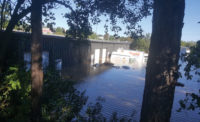The HVAC industry is often influenced by the economy and how well the new construction and service and replacement markets are doing. However, there is another growing sector within the industry: the HVAC rental market. According to a new report from Technavio, the global HVAC rental market is expected to grow at a compound annual growth rate of 7.62 percent between 2018 and 2022.
Per the report, the industrial segment held the largest market share in 2017, accounting for nearly 51 percent of the market. Additionally, the U.S. was the leading region for rental equipment the same year, accounting for nearly 41 percent of the market share.
Many HVAC manufacturers and contractors have taken note of the growing trend and offer rental equipment to their clients. According to Anthony Trifiletti, director of rental services at Trane, an Ingersoll Rand brand, chiller rentals make up a significant portion of the overall temporary cooling market.
“Trane has 10-ton up to 1,000-ton units in our fleet; however, demand for different sizes varies year by year,” he said.
Trane rents chillers to both end users and contractors and can quickly provide temporary equipment to every major metropolitan market in the U.S. and Canada, Trifiletti noted.
EMERGENCY VERSUS PLANNED RENTALS
Most rental jobs typically last around one to two months, Trifiletti said. And, while emergency rentals are a large piece of the market, he actually sees more planned rentals.
“Planned rentals can be for many things, including facility shutdowns and maintenance, seasonal supplemental needs, process improvements, and special events,” he said. “When a permanent chiller fails or has a planned shutdown, temporary chillers can be mobilized to help with comfort or process cooling. Temporary chillers can also provide supplemental cooling during times of peak demand when a facility’s permanent equipment might not have enough capacity to provide the level of cooling that is desired. We have a diverse customer base, including industrial, commercial, and special event customers.”
Temp-Air Inc. supplies rental chillers to both contractors and end users for a variety of applications, including when permanent equipment fails, is in need of major repairs, or if additional chiller capacity is required during the summer months.
“Application types vary from industry to industry and include facilities, such as hospitals, schools and universities, medical clinics, manufacturing processes, food producers, and other industrial processes,” said Scott Brainard, vice president of sales, Temp-Air. “Temporary chillers are versatile and can work in many different industries.”
Daryl Pool, manager, Technical Services Temperature Control, Aggreko, said supplying emergency rentals makes up approximately 30 to 35 percent of Aggreko’s rental business.
“We see a lot of emergency work, but we also do a lot of different types of planned work,” Pool said. “We do a lot of work from an entertainment perspective, whether that’s high-profile sporting events or movie shoots in Hollywood, Houston, and New Orleans. We’re sometimes planning these projects two to three years in advance. Then you have other types of planned work, such as scheduled outages. For example, schools may plan for an HVAC outage during the summer to do some maintenance work on their systems, so we’ll bring in our equipment to supplement their cooling needs.”
Pool said in his 30-plus years at Aggreko, he has used rental chillers in almost every application imaginable, and there’s not necessarily one that’s more suited over another.
“We’ve even done pilot testing,” he said. “We had a pharmaceutical customer approach us because they wanted to develop some products, but did not want to install a permanent chiller until they had a better load profile. So we were able to bring in our equipment, set it up, and help them develop a load profile to lead them into a better purchase from an efficiency perspective on their permanent equipment.”
RENT OR BUY?
There are a number of reasons why facility owners and managers would choose rental equipment over purchasing new equipment, Trifiletti explained.
“Some reasons would be when a customer is more apt to spend maintenance funds versus capital funds,” he said. “And some customers prefer to rent versus buy because the total cost of ownership of a permanent piece of equipment can be higher than the rental equipment. Owned equipment requires the customer to set up depreciation schedules, incur costs of maintaining the equipment, refrigerant costs, and more.”
Brainard said rental equipment can often be sourced quickly and be up and running in a short amount of time, while permanent replacement chillers can often have an extensive lead time that the customer may not be able to wait for.
“We just saw that recently with a client who contacted us about a project because the permanent equipment they ordered was one-year lead time,” said Pool. “They didn’t want to wait; they needed something now.”
He has also worked with companies that did not want to spend capital funding to purchase equipment.
“We had some equipment that was on rent for 20 years,” he explained. “Those aren’t your normal jobs, but this particular customer had a project where they were renting equipment from us and expensing the cost into their plant facilities. We were also responsible for maintaining the unit, and we replaced it every couple of years.”
INCREASING CONTRACTORS’ BOTTOM LINES
The rental market also presents an opportunity for HVAC contractors. In fact, Dallas-based Entech Sales & Service has been offering rental equipment to its customers — and other contractors — since the early 1990s.
“We started Entech in 1981, and we were looking for ways to do business,” said Pat Rucker, president, Entech Sales & Service. “We specialized in servicing large tonnage chillers, and we were looking at ways to increase our revenue, and one of the things we thought about was buying and selling used equipment. We were fairly successful in doing that. We started to accumulate equipment, so we started to use those as rentals, and the rental business kept growing and growing. It has become a pretty good profit center for us.
“We’ve built up a reputation for having rental equipment,” he continued. “Other contractors will call us if they have a client with a breakdown and will rent the equipment from us to install themselves. But often, the contractor will have the customer call us directly and have us install the rental equipment. We have an answering service 24 hours a day.”
Rucker considers rentals just another tool in the bag.
“Whenever you can respond to a customer and provide everything they need, it makes a large difference,” he said. “We’re not only in the air conditioning repair business for large chillers, but we do building automation and security and access. We have plumbing and electrical services as well. These are all tools in our bag. But rental equipment has been profitable for us. In fact, it’s grown to the point where it has surpassed our mechanical service side in Dallas.”
Entech also rents generators, so it furnishes both power and cooling to its clients.
“Emergency power is a big part of our offering, especially with the storms and hurricanes,” he noted. “We have contracts with people like Exxon that reserve equipment every year for storms, and two area hospitals do as well.”
Rucker recently gave a presentation to Chiller System Group (CSG) members about the benefits of adding rental services to their business offerings.
“My point is it’s a logical way to increase their bottom lines,” he said. “Rentals are a very good fit with their existing service and repair business, and the same technicians that provide service and repairs can be used to install and maintain rental equipment. Rental equipment can also be provided to give your company an edge in quoting replacing existing equipment.”
Additionally, adding rental services has led to an unexpected value at Entech, Rucker noted — both on and off the books.
“This business builds esprit de corps,” he said. “Rentals are usually provided on an emergency basis and require a team of people to work on a moment’s notice and work long, hard hours. Whereas most service technicians work alone solving problems, working together with other technicians creates some strong bonds. Additionally, there are many different and challenging applications for rentals, and the guys appreciate the change of pace.”
Publication date: 5/21/2018
Want more HVAC industry news and information? Join The NEWS on Facebook, Twitter, and LinkedIn today!











